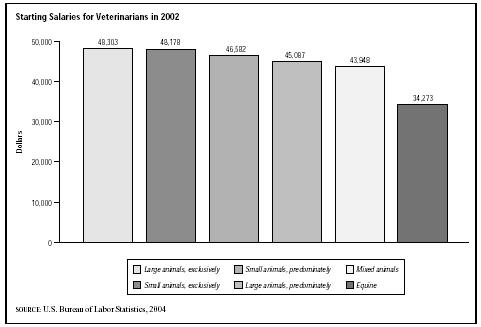SIC 0741
VETERINARY SERVICES FOR LIVESTOCK
This industry consists of establishments of licensed practitioners primarily engaged in the practice of veterinary medicine, dentistry, or surgery for cattle, hogs, sheep, goats, and poultry. Similar establishments primarily engaged in veterinary medicine for all other animals are classified in SIC 0742: Veterinary Services for Animal Specialties.
NAICS Code(s)
541940 (Veterinary Services)
Roughly half of the food Americans eat is derived from animals (in the form of meat and dairy products). Thus, the focus of this industry is largely aimed at maintaining adequate and safe food supplies for humans through the treatment of injuries and diseases of livestock. Because disease accounts for billions of dollars in lost revenue for the livestock industry—around $3 billion in the 1990s and 2000s—veterinary establishments specializing in preventive medicine for larger animals (cattle, sheep, and swine) are integral to increasing livestock productivity and profitability.
Approximately 4,000 private veterinary practices were solely "country vet" practices or large animal clinics, providing treatment and preventive services, including the advising of private and commercial ranchers

and farmers on the care and management of livestock and poultry in the 2000s. Although some practitioners specialize in dairy or beef cattle exclusively, most establishments also provide services for sheep, goats, and pigs; a small percentage also treat poultry.
In contrast to the rest of the veterinary industry, where services are most often rendered in a clinic or hospital setting, most veterinary services for livestock are performed on site—that is, in a barn, out in the field, or on a ranch. A beginning livestock practitioner treating predominantly large animals grossed about $45,087 in 2002 for services rendered, and veterinarians treating large animals exclusively earned about $48,303. The median salary for all veterinarians totaled $63,990. On the other hand, federally employed veterinarians of various capacities (nonsupervisory, supervisory, and managerial) averaged about $72,208 in 2003.
The U.S. Department of Agriculture (USDA) provides veterinary services for researching livestock regulatory medicine. About 2,000 veterinarians were federally employed and engaged in the control and/or elimination of livestock disease and the protection of the public from animal diseases in the 2000s. These services were conducted through the Veterinary Services (VS) division of the Animal and Plant Health Inspection Service, a branch of the USDA. In the early 2000s the VS group worked to eradicate such diseases as cattle brucellosis, swine brucellosis, bovine tuberculosis, and swine pseudorabies. The division was also responsible for compiling information on the state of animal health in the United States—particularly livestock and poultry—through its National Animal Health Monitoring System, a program established in 1983. The USDA also used recently trained veterinarians as meat inspectors.
The passage of the 2002 Farm Bill, signed by President Bush in May of that year, included a more stringent version of the Animal Health Protection Act (AHPA) designed to control livestock disease. For example, the AHPA boosts maximum civil fines to $50,000 for individuals caught smuggling animals or animal byproducts into the United States. Those determined to be smuggling such goods for uses other than personal can now be fined up to $250,000 per violation. As part of the Homeland Security Act passed in response to the terrorist attacks of September 11, 2001, the VS secured additional funding in 2002 to safeguard U.S. animal and food supplies.
Another branch of the USDA, the Livestock and Poultry Sciences Institute, conducted research with the aim of increasing profitability, production efficiency, and the quality and value of livestock products. Among the Institute's laboratories were the Animal Improvement Programs Laboratory, the Meat Science Research Laboratory, and the Growth Biology Laboratory, which conducted research pertaining to the improvement of the growth and development of cattle, poultry, and swine.
Although the practice of caring for and treating animals dates back to ancient Egypt, veterinary services in the United States did not develop until the late 1880s, in response to the growth of the livestock industry. During the late nineteenth century and the first half of the twentieth century, almost all veterinary activities in the United States were associated with livestock, especially cattle, hogs, and sheep. A growing concern for public health in relation to the meat supply gave rise to a need for trained individuals capable of curing and preventing livestock diseases.
The first veterinary practitioners for livestock were generally farmers and ranchers who tended their own animals but otherwise had no formal training. In the late 1800s, however, veterinary schools in the United States began cropping up to provide a more specialized education in this field. At about the same time, state agencies became involved in the regulation of livestock health standards and the licensing of veterinary practitioners, moving livestock health care from the local farm or ranch to a more institutional setting.
The increasing population of the United States has created the need for additional food-producing animals. The current emphasis on scientific methods of breeding and raising livestock and poultry is expected to become even more prevalent, requiring additional specialization in the area of veterinary services for these animals. Advances in livestock production have also created a need for veterinary services related to contamination of the food chain by toxic chemicals. Thus, the demand for veterinary services related to the livestock industry is expected to increase, especially in the area of nutrition and disease control, as the continued integration of veterinary services with the livestock industry will be essential in order to address issues of food safety, quality of environment, and animal welfare.
Further Reading
U.S. Department of Agriculture. Animal and Plant Health Inspection Service. "Animal Health Protection Act." Washington, DC: 2004. Available from http://www.aphis.usda.gov/vs/highlights/section2/section2-3.html .
U.S. Department of Agriculture. Animal and Plant Health Inspection Service. "Safeguarding America's Animal Health." Washington, DC: 2004. Available from http://www.aphis.usda.gov/vs/highlights/section2/section2-2.html .
U.S. Department of Labor. Occupational Outlook Handbook, 2004-05 Edition. Washington, DC: Bureau of Labor Statistics, February 2004. Available from http://www.bls.gov/oco/print/ocos076.htm .
Comment about this article, ask questions, or add new information about this topic: